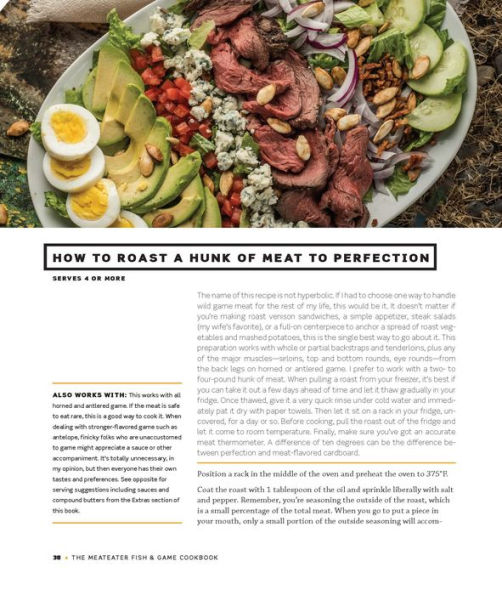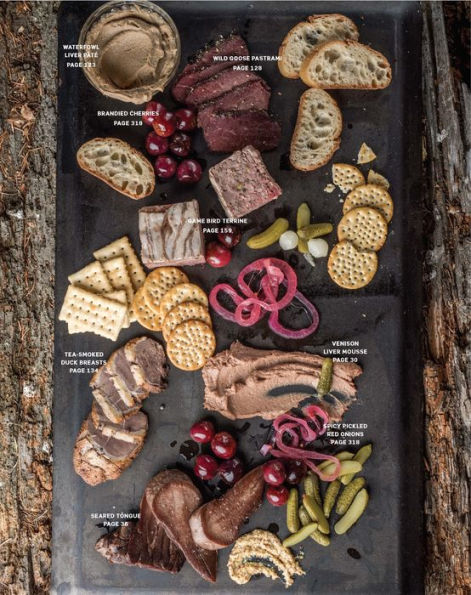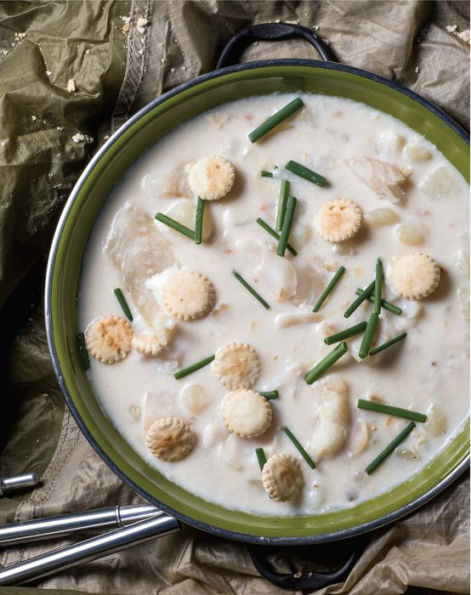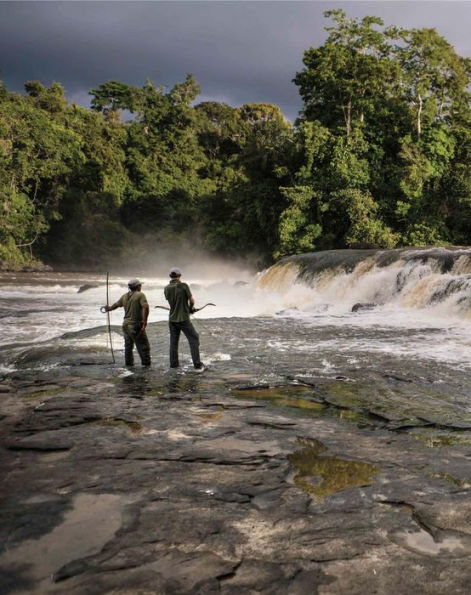Read an Excerpt
01 Big Game
INTRODUCTION
The big game section is in the front of this book because it is a fitting position for what I consider to be the pinnacle of the wild game world. While I regard myself as a hunting generalist (I’ll chase anything that’s good to eat, and at times my definition of good has been elastic enough to include everything from common carp to porcupines), big game hunting is my deepest passion. I killed my first deer when I was thirteen, after two unsuccessful seasons of misses and mistakes. I’ve kept at it, without ever missing a season, for the past thirty-three years. Every fall and winter, I put fifty days or more into pursuing big game. I believe that it’s the most challenging form of hunting, both physically and mentally, and it pays off in the biggest way. Long ago, I committed to feeding my family a diet of wild meat. Big game is how I’m able to stay true to that commitment.
Most hunters share my fondness. According to statistics from the U.S. Fish and Wildlife Service, 80 percent of all hunters chase big game at some point during the year. Each of those hunters has his or her own particular set of motivations, but you can’t argue with the seductive size of big game animals. A mature whitetail deer can yield anywhere from forty to eighty pounds of boneless, recipe-ready meat. An elk can yield well over two hundred pounds. A moose, well over three hundred pounds. In addition to abundance, big game also gives you variety. I break my deer down into a dozen different cuts, ranging from short ribs to sirloins to tongue. Each cut is suitable for an endless array of recipes and preparations. With just a single deer in your freezer, you can have months’ worth of eating with no fear of redundancy or boredom.
This cut-based approach is the key to big game cooking. It remedies a problem that I have with wild game cookbooks in general, which tend to draw unnecessary distinctions among various species of antlered and horned game. To me, there is no fundamental difference between a recipe for a pronghorn antelope shank and a recipe for a whitetail deer shank beyond some minor adjustments in cooking times. In fact, I’d argue that it’s more important to understand what part of the animal you’re cooking than it is to understand what kind of big game animal it came from.
Keep this approach in mind as you work through this section. Virtually every recipe here is interchangeable from one big game species to the next. Admittedly, the recipe for Kimchi Tacos with Wild Pig or Javelina shoulder on page 152 is especially suitable for the stringier meat and sometimes stronger flavors of those particular animals. But it could easily be applied to a venison shoulder or bear shoulder, as all three of these pieces of meat share in common a lot of sinews and connective tissue that will break down during the cooking process and yield a finished product that is rich, moist, and silky. This is just one example where substitutions are appropriate; I have called out many others in the following recipes. I’m hopeful that you’ll make additional discoveries on your own as you apply these methods to whatever big game happens to turn up in your freezer over the coming years.
Finally, I’d like to throw in a few thoughts on the subject of big game meat that tastes “gamey,” a term that drives me a little bit insane every time I hear it. As best as I can tell, gamey has no fixed definition. I’ve heard it used to describe a dozen or more different things. It’s used to describe meat that was spoiled, meaning rotten, from improper handling in the field. I’ve heard it used to describe meat that hadn’t been trimmed of tallow and blood clots. I’ve heard it used to describe meat that had been tainted by secretions from the tarsal gland on a deer’s back leg. And I’ve heard it used by people who are trying to say that game meat doesn’t taste like the flavorless beef that they’re used to buying from fast-food restaurants.
Whatever it actually means to you or the people you’re cooking for, most causes of gamey meat can be eliminated by taking a careful approach to your hunting techniques and field care. First off, don’t let fly with an arrow or bullet unless you know exactly what’s going to happen when you do it. There is no place for guesswork or surprises when it comes to marksmanship. You need to put your projectile cleanly through the lungs and/or heart of the animal for a quick, clean kill. Poor shot placement can lead to an animal being heavily stressed before it eventually dies. When that happens, there’s a chance that the animal could indeed have tough meat with strong, off-putting flavors.
Gut the animal immediately. Big game animals have an internal body temperature of over one hundred degrees. Once the animal is dead, that heat will quickly spoil the meat. The area around the ball joints, at the base of the rear legs, is the first to go. Removing the guts helps cool things down. In this chapter you’ll see how to properly do the job. After gutting, pack the chest cavity with ice or snow. If need be, quarter the animal and get the quarters into a walk-in meat locker, a household fridge, or even a cooler loaded with ice. Whatever it takes, keep the animal cold and dry until you’re ready to butcher it. And when it comes to butchering, keep things cold and clean and follow the directions that are laid out here. You’ll eliminate the majority of your gamey situations.
But no amount of careful shooting and trimming is going to change the minds of squeamish folks who think that anything other than domestically produced meat tastes different and, therefore, gamey. What will change their minds is repeated exposure to what real meat actually tastes like. It only helps when it’s properly prepared and served. Getting a deer—or an elk, moose, caribou, or bear—in your freezer is the first step of the process. This chapter is the second step. Enjoy.
The Big Buck/Little Buck Myth
A lot of hunters have this idea that big bucks aren’t that good to eat. This is nonsense. There are myriad factors that influence the palatability of a deer; age is hardly the defining one. We put this idea to the test on a Colorado mule deer hunt when we killed two bucks. The first was a three- to four-year-old giant; the second was a year-and-a-half-old forky. Served raw, the unanimous consensus was that the bigger and older ham was a better piece of meat. In all fairness, the older buck had been aged a day or so longer—which goes to show that factors beyond the animal’s age are at play when it comes to quality meat.
THE NATURE OF THE BEAST
American Pronghorn (Antelope)
The meat of the American pronghorn, or antelope, tends to be rather polarizing. Critics often say that it tastes gamey or musky, while fans of antelope will say that the faint hint of sage is a welcome attribute that brings to mind the open landscapes of the American West. Unpleasant experiences with antelope meat can be avoided if the hunter practices good marksmanship and field care. If you follow all of the advice within this book, you’ll find that antelope have an excellent flavor on par with the finest big game animals.
Black Bear
During the time of Daniel Boone, black bear was the preferred meat on the American frontier. Deer were good for buckskin clothes, bear was good for eating. There’s no reason to think any differently about black bear meat today. Trimmed of fat, the meat is excellent and can be used for a wide variety of purposes. When slow-cooked or braised it resembles beef pot roast in texture and flavor. The quality of the meat does vary according to the animal’s diet. Bears that have been feeding on fish or marine mammals can have an off-putting fishy taste. A bear that’s been feeding heavily on rotten carrion can also taste bad. These occasions are rare, however, as most black bears derive the bulk of their diet from plant matter. Some of the best bear meat comes from animals feeding on berries or hardwood mast. When baiting bears, avoid using animal or fish matter so that you don’t taint the flesh of the animals that you’re hunting. Trichinosis is another consideration with bear meat. Unless you’ve had your animal tested, it’s safe to assume that all bears are infected by microscopic Trichinella larvae—the same larvae that used to commonly infect domestic pork and is still present in wild hogs. Destroying the threat is simple: cook all bear meat to 160°F and you’re safe.
Caribou
Complaints about the gamey qualities of caribou meat can often be attributed to bulls killed during the rut. Caribou flesh seems to be affected by the hormonal changes of the breeding season in a more dramatic way than any other big game animal. For most hunters, this isn’t an issue, because caribou are typically hunted between late August and early October, before the rut begins. People accustomed to eating beef are likely to recognize caribou meat as being “different,” though it is highly prized by hunters who live in caribou country. The meat is often more tender than other antlered game, to the point that some people have described it as “pasty.” Its coloration is sometimes lighter, too, and it can lack the deep mahogany color that characterizes the flesh of other members of the deer family. Caribou meat can be used in any recipe calling for venison.
Elk
Elk are widely regarded as the best of the best among wild game meats and are often compared to grass-fed beef. There is no such thing as a bad-tasting elk, and rarely does anyone complain about gamey elk. Older animals can be tough, but aging and proper cooking methods can take care of that. Elk meat can be used for any recipe calling for venison.
Moose
In the north, moose meat is as popular among hunters as elk meat is in the Rockies. While it doesn’t prompt as many comparisons to grass-fed beef, it is mild and easily approachable. The flesh is heavily grained and colored a deep, rich red. It is generally a tougher, chewier meat than whitetail deer. It’s a good practice to age your moose meat for a week or so before butchering. If you can’t do that, you can let your butchered cuts rest in the freezer for a few months. You’ll find that the meat gets better and better as time goes by. Moose can be used in any preparation calling for venison.
Mule Deer
Most people would have a hard time distinguishing mule deer meat from the meat of a whitetail deer. Occasionally you’ll encounter a mature mule deer that has a ruttier and muskier taste than you’d find on a whitetail, but generally they are excellent. The best meat comes off the animals that are in the best condition, regardless of age or gender. If it’s killed quickly and handled properly, a well-fed mule deer buck with a good layer of fat on its rump is going to provide some of the most tender and pleasantly flavored meat that you’ll ever encounter.
Whitetail Deer
Whitetail deer are by far the most widely consumed game meat in the United States. If care is taken to avoid contamination by the fluids produced by the tarsal glands on the animal’s rear legs, the meat is exceptionally mild and usually quite tender. Most people who have a familiarity with both whitetails and elk will choose elk as their favorite, though whitetail meat is highly regarded by most hunters.
Wild Pigs
Wild pigs, or feral hogs, are the exact same species as the farm-raised varieties of pigs that you can find in a butcher shop or grocery store: Sus scrofa. The difference is that wild pigs are far leaner than domestic pigs, as they eat a lot less food and get a lot more exercise. For perspective, consider that it’s virtually unheard of to find a wild pig that can be used to make a slab of bacon. Because of their leanness, wild pig flesh has more in common with venison than it does with commercially produced pork. It is generally regarded as more flavorful and complex than domestic pork. When cooking with it, you usually need to add fat and take measures to prevent it from drying out. Younger pigs generally have better meat than older pigs. Many hunters prefer the flesh of a pregnant sow above all others, as they have a lot of stored body fat. Most hunters regard sexually mature boars as the least desirable when it comes to eating. At times, their meat can be very tough, with an off-putting odor. Diet matters with wild pigs. Animals feeding on green grass or acorns, for instance, will likely have much better meat than animals who are ingesting lower-quality foods or animal matter. Wild pigs often carry microscopic Trichinella larvae in their flesh, which can cause the disease trichinosis. (The larvae used to be carried by domestic pigs as well, though it’s been virtually eradicated from pigs raised in accordance to USDA guidelines.) Cook all wild pork to 160°F and you’re safe.
gutting Big Game Animals
Wild hogs, like the one pictured here, share the same basic anatomy with all hooved big game animals. The process of skinning, gutting, and butchering any big game animal is basically the same, whether it’s a wild pig or a whitetail deer. But there are different approaches to big game field care. Here Ben Binnion, a commercial wild hog trapper who has handled thousands of wild hogs, demonstrates a clean and efficient way to go about this process. For additional information on butchering big game animals check out The Complete Guide to Hunting, Butchering, and Cooking Wild Game, Volume 1: Big Game.
How to Gut Big Game Animals
1. Because this hog was trapped and shot in the head, it was necessary to bleed it out by cutting its throat immediately after the shot. Bleeding out a big game animal can give the meat a cleaner taste and better appearance, but it is unnecessary if the animal was shot in the vital heart/lung area with a rifle or bow.
2. Start by cutting through the skin around the genitals and down to the anus. Be extremely careful to cut only the hide without puncturing the gut cavity. Once this cut is made, use your knife to separate the skin and genitals from the carcass. This hog was trapped in Texas, where leaving evidence of sex on the carcass is not a legal requirement. However, some state game agencies do require that you leave evidence of sex naturally attached to the carcass of big game animals. (Read more on page 16.)















